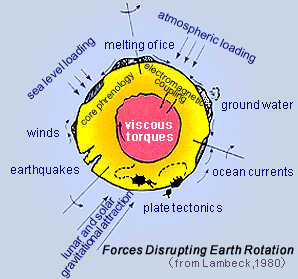The Earth rotates once a day, but its rotation speed (length of day) and
its rotation axis (direction of its north pole) are not constant, disturbed
by lunar gravity and various dynamic phenomena of the Earth (see right
figure). Using far distant celestial objects as targets, VLBI is one of
the few techniques that can monitor the Earth's rotation and orientation.
This information is necessary to perform orbit controls of satellites and
space crafts, including GPS. Furthermore, it sheds lights on the dynamics
of the inner Earth that can not be directly observed. |
 |
![[UT1-UTC] obtained byVLBI data](../image/en_whatisvlbi_objectives03_03.gif) |
The left figure, which compares the time based on the Earth rotation determined by VLBI (Universal Time:UT1) to the time based on precise atomic clocks (Coordinated Universal Time:UTC), shows that the Earth rotation is gradually slowing down. |
| uUT1-UTCv obtained by VLBI data |
| |
|
|